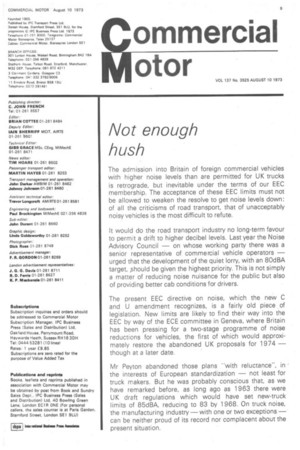Not enough hush
Page 11

If you've noticed an error in this article please click here to report it so we can fix it.
The admission into Britain of foreign commercial vehicles with higher noise levels than are permitted for UK trucks is retrograde, but inevitable under the terms of our EEC membership. The acceptance of these EEC limits must not be allowed to weaken the resolve to get noise levels down: of all the criticisms of road transport, that of unacceptably noisy vehicles is the most difficult to refute.
It would do the road transport industry no long-term favour to permit a drift to higher decibel levels. Last year the Noise Advisory Council — on whose working party there was a senior representative of commercial vehicle operators — urged that the development of the quiet lorry, with an &MBA target, ,should be given the highest priority. This is not simply a matter of reducing noise nuisance for the public but also of providing better cab conditions for drivers.
The present EEC directive on noise, which the new C and U amendment recognizes, is a fairly old piece of legislation. New limits are likely to find their way into the EEC by way of the ECE committee in Geneva, where Britain has been pressing for a two-stage programme of noise reductions for vehicles, the first of which would approximately restore the abandoned UK proposals for 1974 — though at a later date.
Mr Peyton abandoned those plans "with reluctance", in the interests of European standardization — not least for truck makers. But he was probably conscious that, as we have remarked before, as long ago as 1963 there were UK draft regulations which would have set new-truck limits of 85dBA, reducing to 83 by 1968. On truck noise, the manufacturing industry—with one or two exceptions — can be neither proud of its record nor complacent about the present situation.




























































































